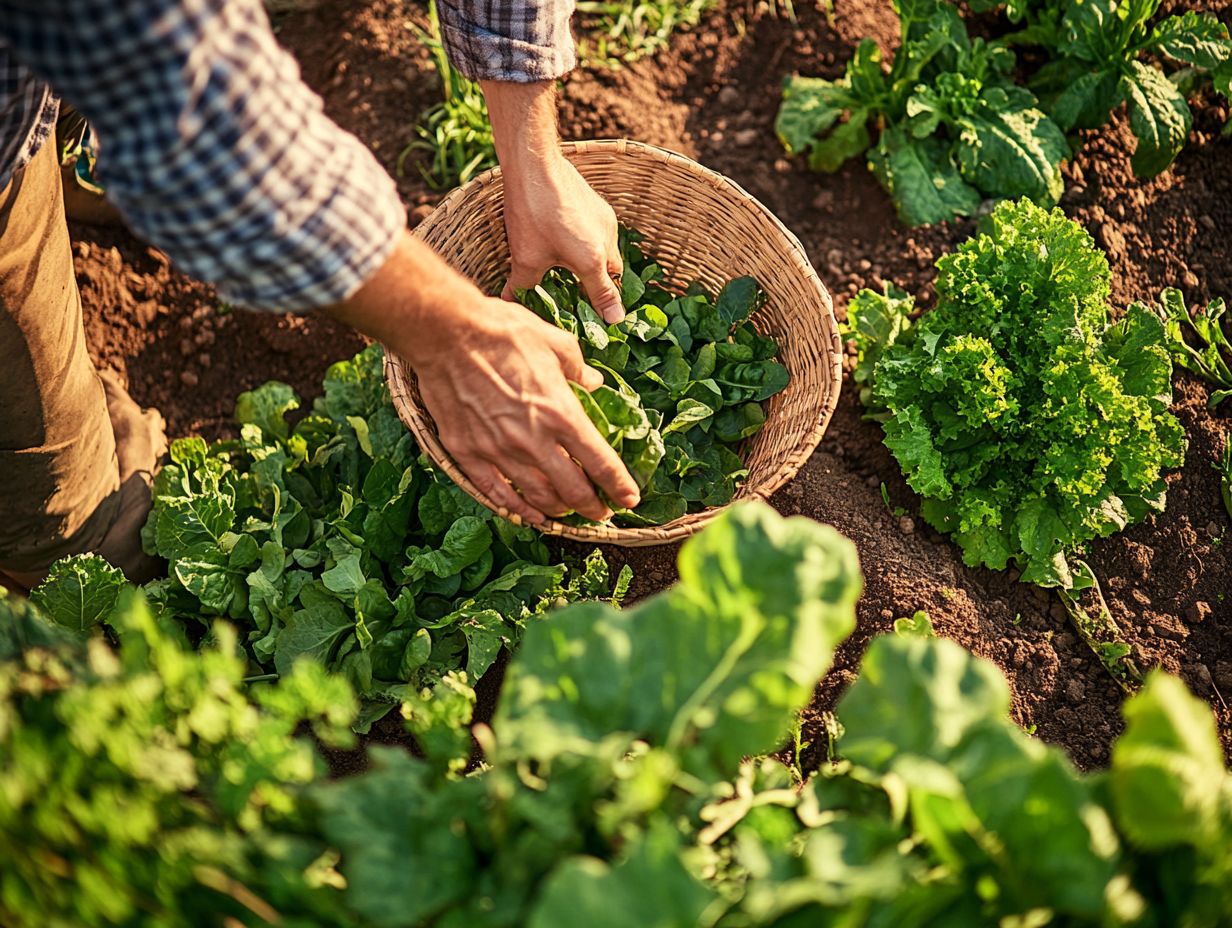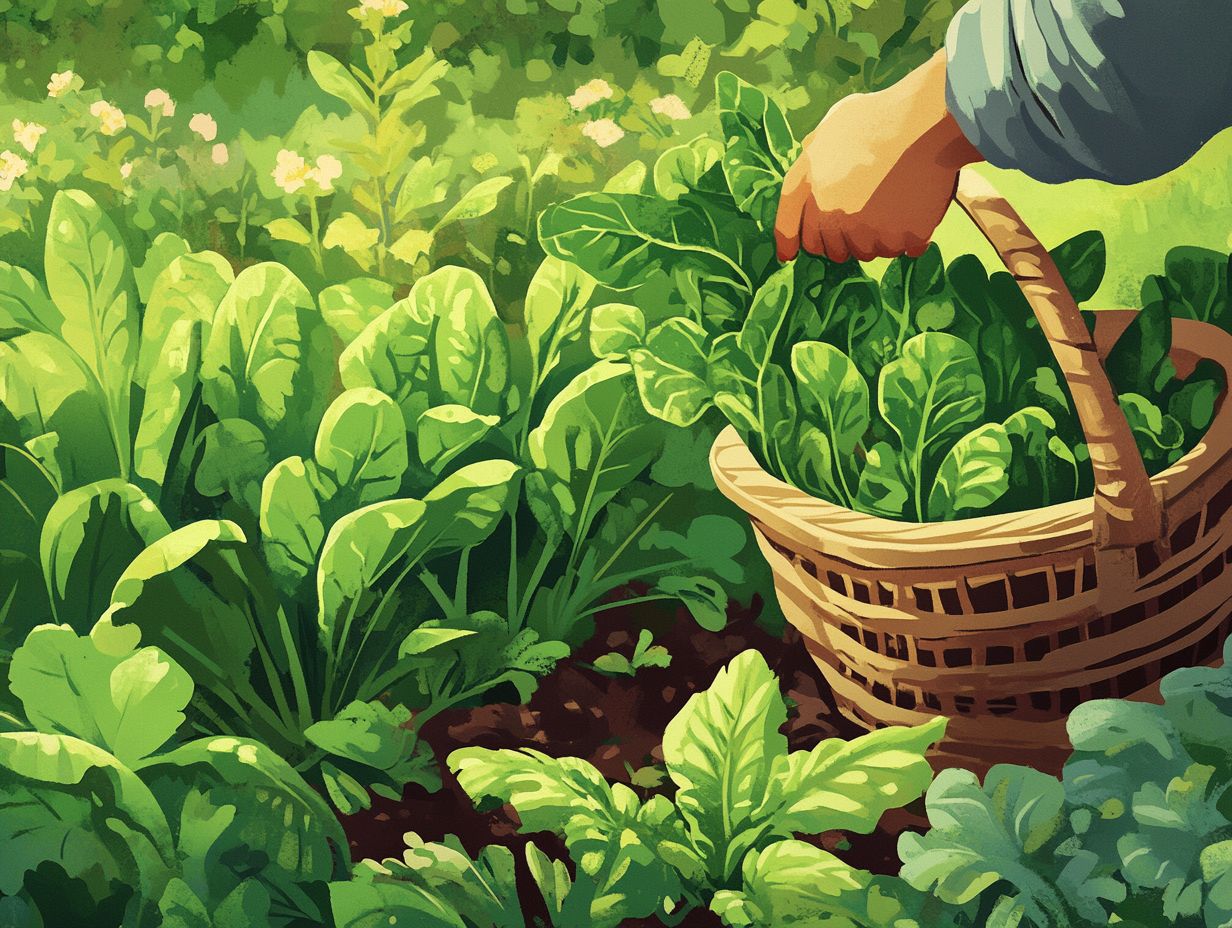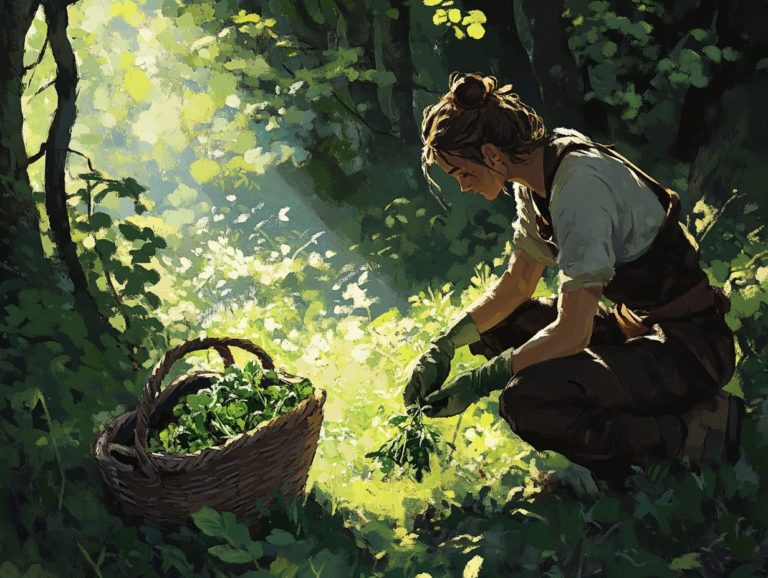Harvesting Edible Plants: Best Practices
Harvesting edible plants offers a rewarding journey that connects you to nature and elevates your culinary experiences.
This guide will walk you through the essential steps for identifying and selecting edible plants, providing insights into common varieties found in various regions. Learn effective techniques for harvesting. Discover the right tools to enhance your foraging experience and best practices for preserving your bounty.
We will discuss crucial safety precautions to ensure your foraging adventures are enjoyable and safe. Dive into the exciting world of edible plants today!
Contents
- Key Takeaways:
- Identifying and Selecting Edible Plants
- Harvesting Techniques and Tools
- Storing and Preserving Edible Plants
- Safety Precautions for Harvesting Edible Plants
- Frequently Asked Questions
- What are the best practices for harvesting edible plants?
- When is the best time to harvest edible plants?
- How do I know if an edible plant is ready to be harvested?
- What tools should I use for harvesting edible plants?
- What should I do after harvesting edible plants?
- Is it okay to harvest edible plants from the wild?
Key Takeaways:

- Always properly identify edible plants before harvesting to avoid potential risks.
- Use recommended tools and best practices for harvesting to ensure the safety and quality of edible plants.
- Properly store and preserve edible plants using appropriate methods to prolong their shelf life and avoid contamination.
Why Harvest Edible Plants?
Harvesting edible plants isn’t just about gathering food; it’s an engaging journey that deepens your connection with nature, fosters community learning, and positively impacts the environment. By embracing sustainable foraging, you’re invited to explore the rich abundance of wild plants in your local ecosystem, including the top 10 edible plants to harvest sustainably, while grasping the importance of ethical and responsible harvesting methods.
This practice enhances your diet with diverse and nutritious options and heightens your awareness of the environmental implications of your food choices, especially amid the climate crisis.
With every forage, you ll gain valuable insights into plant identification and the remarkable nutritional benefits these wild foods provide. Many edible plants are rich in vitamins, minerals, and antioxidants, often surpassing their cultivated counterparts in nutrient density.
The cultural significance of these plants is profound; they carry stories and traditions that enrich the community’s shared heritage. As you gather with others to learn and explore foraging, you strengthen bonds and cultivate a supportive network that celebrates both the land and its bountiful offerings.
In this eco-conscious endeavor, foragers like you not only nourish your bodies and minds but also actively promote biodiversity and encourage sustainable practices that protect our planet for future generations.
Identifying and Selecting Edible Plants
Identifying and selecting edible plants is essential for sustainable foraging. It requires a keen understanding of wild plant characteristics, the ability to recognize edible varieties, and the skill to distinguish them from toxic look-alikes plants that may appear similar but can pose safety risks.
Mastering proper plant identification is fundamental to ensuring safe foraging practices, allowing you to enjoy the wild abundance surrounding you without jeopardizing your health. With resources like foraging books and community learning opportunities, you can confidently navigate the diverse realm of edible plants and refine your skills.
Common Edible Plants in Different Regions
Across various regions, you can discover an array of common edible plants ripe for foraging, each one bringing its unique flavors and nutritional perks.
Take wild garlic, for instance. It makes its glorious debut in early spring, boasting a distinctive aroma that elevates any savory dish. Then there s sorrel, with its tangy notes, thriving in gardens and woodlands alike perfect for jazzing up salads or soups.
As summer wanes, you ll find succulent wild blueberries, a delightful, antioxidant-rich snack. Chicory, with its slightly bitter crunch, is another gem; it s often tossed into salads or brewed as a coffee substitute.
By synchronizing your harvesting efforts with the seasons, you can appreciate and make the most of these diverse plants, enhancing your personal wellness while contributing to environmental stewardship.
How to Properly Identify Edible Plants
To effectively identify edible plants, arm yourself with both knowledge and the right tools for plant identification. This allows you to confidently distinguish between the delightful and the dangerous. Familiarize yourself with wild plant features such as leaf shape, growth patterns, and flowering times.
Utilizing resources like foraging books and engaging in community learning will significantly elevate your skills. This ensures you approach foraging safely and responsibly.
This foundational knowledge helps you make informed choices. Specific visual cues like leaf coloration and texture can hint at a plant’s edibility. Relying on your senses, including scent and taste, enhances safe foraging practices and helps identify beneficial species.
Stay sharp and alert to avoid common toxic plants like poison ivy or elderberry. Consuming these by mistake can lead to unpleasant consequences.
Consult trusted guides and local experts; their insights profoundly influence your safe harvesting practices. This paves the way for a rewarding and secure foraging experience.
Harvesting Techniques and Tools

Effective harvesting techniques and the right tools are essential for your successful foraging endeavors. They enable you to gather wild plants in a sustainable and responsible manner. Whether you’re using sharp scissors for delicate herbs or sturdy baskets for bulkier finds, the proper equipment enhances your foraging experience while minimizing environmental impact.
It’s important to follow seasonal harvesting practices. This respects the life cycles of plants and promotes the health of local ecosystems.
Best Practices for Harvesting
Implementing best practices for harvesting is crucial for ensuring your foraging efforts are sustainable foraging. This helps maintain the health of wild plants and fosters a sense of environmental stewardship. Embrace principles like ‘leave no trace’ to protect natural habitats and support biodiversity.
By adhering to established harvesting guidelines, you engage in ethical foraging. Utilizing the best tools for foraging edible plants minimizes your ecological footprint while reveling in nature’s bounty.
Understand the specific needs of local ecosystems to make informed decisions about what and how much to harvest. Do not overharvest this is crucial for the survival of our local ecosystems! Leave enough plant material behind to allow for regeneration.
Familiarize yourself with seasonal variations and gather only when plants are robust and thriving. For more insights, check out this seasonal guide on foraging techniques, as this significantly enhances ecological balance.
Practicing responsible foraging enriches your personal experiences and nurtures a sense of community. Share knowledge and foster a collective commitment to preserving these resources for future generations. This creates a vibrant culture of foragers dedicated to sustainability.
Recommended Tools for Harvesting
- Sharp knives or scissors for precise cutting.
- Sturdy baskets for transporting your treasures.
- Field guides or foraging books to help you swiftly identify your finds.
- A reliable digging fork or trowel for extracting roots or tubers without causing damage.
- A good pair of gloves to protect your hands from thorns and irritants.
- A reusable water bottle to keep hydrated during longer excursions.
Investing in a dependable smartphone app that assists with plant identification and offers tips on sustainable foraging practices can be a game changer. Many enthusiasts discover that joining foraging groups broadens their knowledge and fosters a sense of community.
This transforms solitary foraging trips into shared adventures filled with collaboration, learning, and essential safety tips for navigating various foraging scenarios.
Join a local foraging group today and share the excitement of discovering nature’s hidden gems!
Storing and Preserving Edible Plants
Storing and preserving edible plants is essential for maximizing the benefits of foraged foods. To truly enjoy the wild abundance long after the harvest season has concluded, consider exploring the most nutritious edible plants to forage.
Using proper storage methods like refrigeration, freezing, and dehydration helps maintain the freshness and nutritional value of wild plants. Using effective preserving techniques like canning and pickling ensures you can enjoy your foraged foods year-round.
This not only reduces waste but also enhances the diversity of your diet.
Proper Storage Methods
Utilizing proper storage methods is crucial for maintaining the quality and longevity of foraged wild plants. This allows you to savor their flavors long after the harvest.
Knowing the best practices for storage and understanding the specific needs of different varieties is key. For example, leafy greens like dandelion and lamb’s quarters should be refrigerated in a plastic bag to keep them fresh. In contrast, root vegetables thrive in a cool, dark place like your basement or cellar.
If you re looking to preserve herbs like wild thyme or wild mint for the long haul, drying them is a fantastic option. Store them in airtight containers to enhance your culinary creations throughout the year.
When it comes to canning, following safety rules is vital to prevent spoilage. This ensures that the wild plants remain safe and delicious for your enjoyment.
Master the Art of Preserving Your Edible Plants

Using preservation techniques is essential for enjoying edible plants long after their harvest. This allows wild foods to play a significant role in your sustainable diet. Methods such as canning, pickling, and fermenting not only extend the shelf life of these plants but also enhance their flavors. By mastering these techniques, you can savor your harvests throughout the year.
These methods help maintain the nutritional value of the plants, guaranteeing that their health benefits are preserved alongside their unique tastes. For instance, canning involves sealing foraged fruits and vegetables in jars, creating a seal that keeps air out to inhibit spoilage. In contrast, pickling uses acidity to prolong freshness while adding a tangy twist to your dishes.
Fermenting is another excellent option that promotes beneficial bacteria, offering both preservation and a probiotic boost. Each technique opens up new culinary possibilities, transforming wild edibles into delectable staples you can enjoy year-round.
Safety Precautions for Harvesting Edible Plants
Stay safe while foraging by taking the right precautions! This not only protects you from the risks associated with toxic plants but also minimizes potential contamination.
Understanding common poisonous look-alikes, such as hemlock and poison ivy, is crucial for your safety while foraging. By implementing strategies to minimize risks like wearing appropriate clothing and using clean tools you set yourself up for a successful and enriching foraging adventure.
Avoiding Contamination and Poisonous Plants
Avoiding contamination and identifying poisonous plants are essential aspects of finding safe plants to eat. They significantly reduce the risks associated with harvesting wild flora.
You need to be vigilant in recognizing toxic varieties, such as oleander and the death cap mushroom. Always adhere to foraging guidelines that prioritize safety.
Implement proper cleaning techniques to decrease contamination risks. Ensure your harvesting tools are sanitized.
Familiarizing yourself with your local ecosystems is crucial. This knowledge helps you distinguish between safe edibles and harmful species.
Keeping a foraging journal is incredibly beneficial for tracking your findings and any adverse reactions. This practice ultimately enhances your overall safety.
Consider consulting local experts or utilizing field guides that highlight both common edible plants and their poisonous counterparts.
Follow these safety tips to enjoy a delicious and safe foraging adventure! You not only protect your health but also promote sustainable foraging. This ensures that these natural resources remain available for future enthusiasts.
Watch this video to learn more about safe foraging practices!
Frequently Asked Questions
What are the best practices for harvesting edible plants?
Some best practices for foraging include waiting until the plant is fully ripe, using clean tools, and harvesting sustainably during the coolest part of the day.
When is the best time to harvest edible plants?
The best time to harvest edible plants is typically in the morning when the plants are the most hydrated and the temperature is cool. To ensure safety while foraging, it’s important to learn how to forage edible plants safely.

How do I know if an edible plant is ready to be harvested?
You can tell if an edible plant is ready to be harvested by checking if it is fully ripe and if it easily detaches from the plant.
What tools should I use for harvesting edible plants?
It is best to use clean and sharp tools, such as gardening shears or a knife. This helps prevent damage to the plant and ensures a clean cut.
What should I do after harvesting edible plants?
After harvesting, clean the plants thoroughly and store them in a cool, dry place to maintain their freshness.
Is it okay to harvest edible plants from the wild?
It is generally not recommended to harvest edible plants from the wild, as they may be contaminated or endangered. However, if you choose to forage, be sure to follow safety guidelines for harvesting wild edibles. It is best to purchase plants from a reputable source or grow them in a controlled environment.






